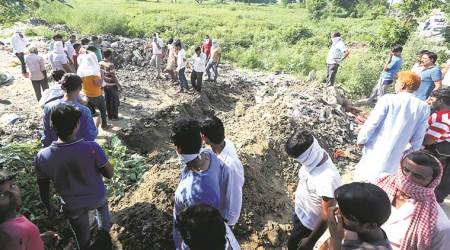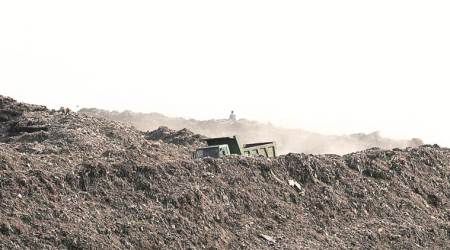 The landfill at Okhla, shut down in the wake of the Ghazipur garbage collapse that killed two people. (Express Photo/Praveen Khanna)
The landfill at Okhla, shut down in the wake of the Ghazipur garbage collapse that killed two people. (Express Photo/Praveen Khanna)
For almost two decades, solutions for Delhi’s waste have revolved around either finding an alternate landfill site or relying on waste-to-energy (WTE). But the case of the Okhla landfill — shut down after the Ghazipur landfill collapse killed two people last week — underlines the problems with both these options. Reiterating an 11-year-old plan, Lieutenant Governor Anil Baijal, in the wake of the Ghazipur collapse, directed that municipal corporations increase the capacity of existing WTE plants to ensure that waste is cleared on a war footing. The view has been endorsed by Chief Minister Arvind Kejriwal who, in 2015, had also campaigned against the plant at Okhla.
But Ranjit Devraj, a resident of Sukhdev Vihar who has been spearheading the protest against the Okhla plant, pointed out that the ambitious plan is not without problems. “The WTE plant continues to pollute. They were supposed to segregate waste, which they haven’t done,” said Devraj, who approached the Supreme Court against the plant despite the National Green Tribunal giving it the all-clear in 2016.
Central Pollution Control Board member secretary B Sengupta elaborated that “in Western countries, where there is no space for landfills, they have been able to convert waste to energy in a highly scientific manner”. But here, he said, the problem is “one of implementation”. For example, the European Union’s directions on incineration of waste mandate a 90% reduction of dioxin emissions and a 70% reduction of heavy metals. But that’s far from the case here.
Read | What lies buried Part I: 14 years, fourteen red flags on Delhi’s landfills ignored
An SDMC official admitted, “Waste segregation is almost impossible to do once the waste has been collected. It needs to be done at the source. Only then is the calorific value of the waste enough for power to be generated, while harmful pollutants can be weeded out.”
Waste segregation at source means dividing waste into dry and wet before it reaches the landfill. Dry waste includes wood and related products, metals and glass. Wet waste, typically, refers to organic waste.
With the SDMC starting segregation of waste at the source at select locations in June 2017, mayor Kamaljeet Sehrawat struck a hopeful note. “What we are expecting is that with the second WTE plant (slated to come up at Tekhand, not far from the Okhla landfill), we will be able to reduce the amount of waste that goes into the landfill massively. Segregation will also start,” she said.
The Tekhand plan, though, has already flown into rough weather, with residents protesting protests against the proposed WTE plant. “This area is already very polluted because of the traffic along the highway. The trucks make it impossible for us to breathe during winters. This plant will make things worse,” said Sachin Joshi, a resident.
The land problem
While the relative inefficiency of WTE plants without waste segregation is one problem, the other is of getting land to the dump the waste the capital produces — estimated to be 10,000 tonnes per day. Over the years, the MCD has proposed a series of landfill sites, the biggest among them being 1,500 acres of land at Bhatti Mines. The proposal came after a 2000 report which argued that the site could meet Delhi’s landfill needs for the next 25 years.
But the fact that the site lay within the Asola Bhatti Forest Reserve and the ecologically sensitive Aravalli range meant getting an approval for a landfill there would never be easy. In 2013, when the DDA listed 11 new sites for garbage disposal to the Delhi High Court, the largest again was 500 acres of land near Bhatti mines. The same year, the south corporation reiterated the proposal. But the High Court rejected the proposal, saying the land was “disputed”.
A Delhi government official said the main concern was over “its impact on the water table”. The official explained, “The area is in an eco-sensitive zone within the wildlife sanctuary and close to two villages. Concerns were raised about leachate emissions from the landfill.” Further, the area falls within the fragile Aravalli range, “which is a major water catchment area”, added the official.
Similarly, the DDA’s proposed landfill site for the EDMC at Ghonda Gujran was denied because it was on the floodplains, with NGT raising concerns over water contamination.
An official of the DDA explained the issue: “In Delhi, where land has become extremely scarce, this is the major problem. The only areas where land is available and not close to habitation are in such ecologically sensitive areas — either in the southwest like Bhatti mines, or along the river Yamuna.”

